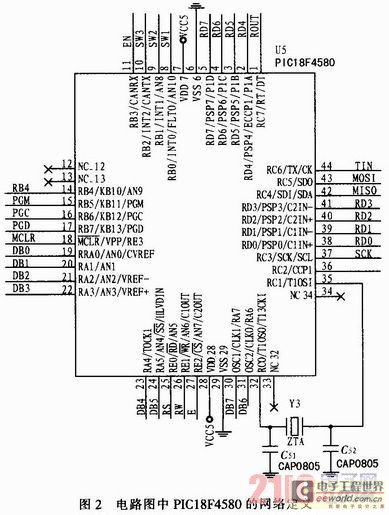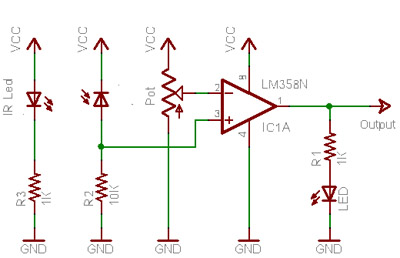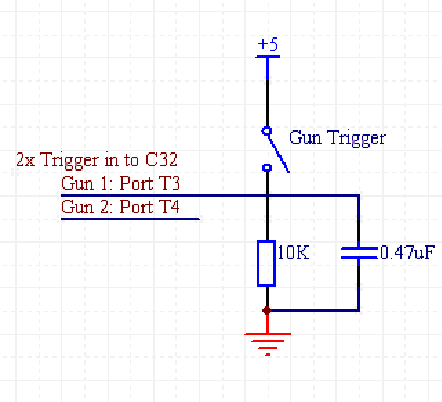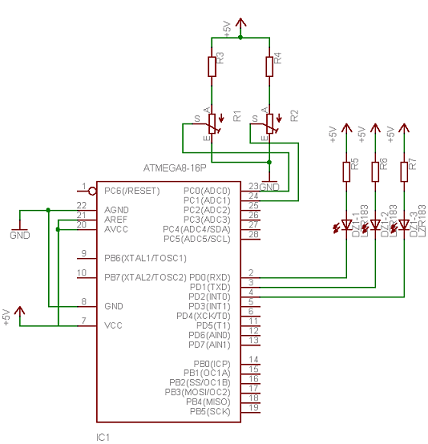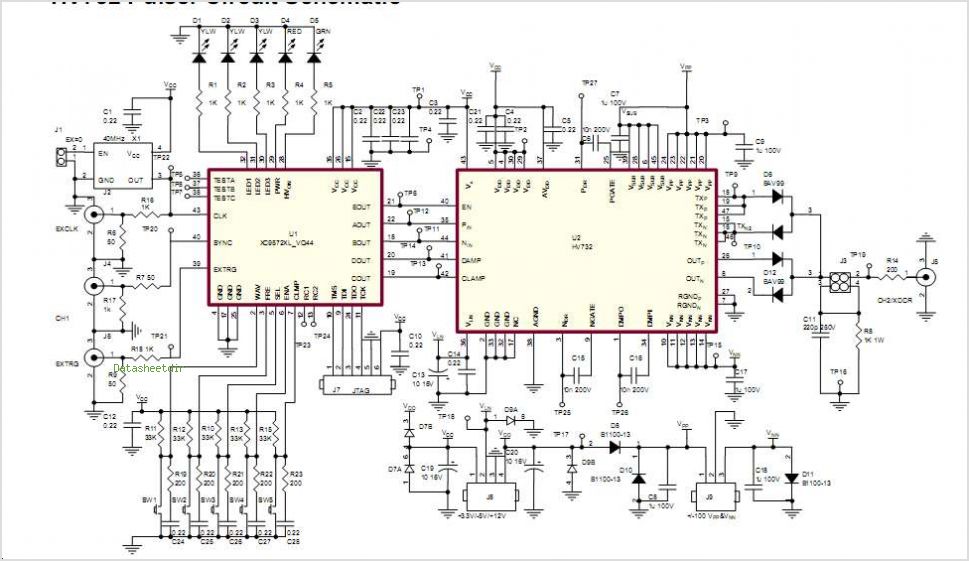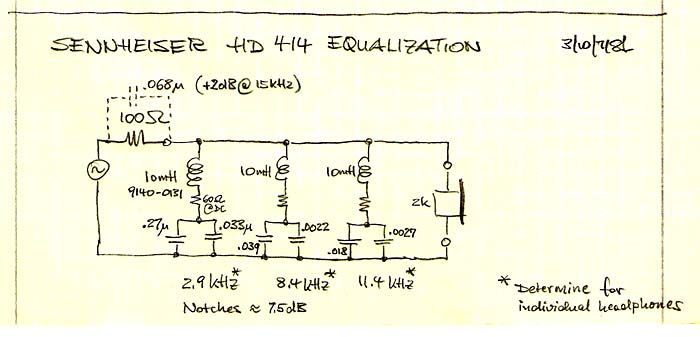
reference design modern prtd sensors and delta sigma adcs
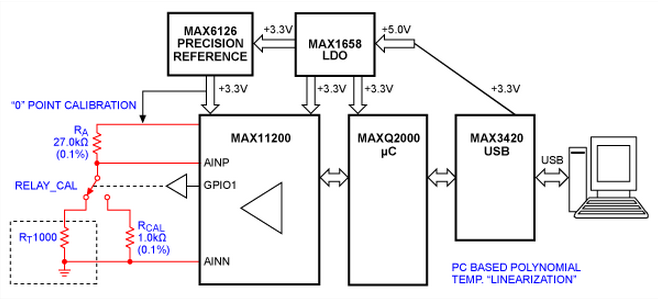
This article explains how platinum resistance temperature detectors (PRTDs) can perform measurements over wide temperature ranges of -200 °C to +850 °C, with absolute accuracy and repeatability better than ±0.3 °C, when used with modern processors capable of resolving nonlinear mathematical equations quickly and cost-effectively. This article is the second installment of a series on PRTDs. For the first installment, please read application note 4875, High-Accuracy Temperature Measurements Call for Platinum Resistance Temperature Detectors (PRTDs) and Precision Delta-Sigma ADCs. This article explains how to achieve high-performance precision, wide-range temperature measurement for platinum resistance temperature detectors (PRTDs), using a data-acquisition system (DAS) comprised of a delta-sigma analog-to-digital converter (ADC) and a modern processor. This DAS offers high performance yet is cost-effective. The development DAS presented here resolves design and mathematical challenges quickly and achieves precision temperature measurement in the PRTD's maximum range (-200 °C to +850 °C). Platinum resistance temperature detectors, or PRTDs, are absolute temperature-sensing devices that can assure repeatable measurements over temperature ranges of -200 °C to +850 °C. Platinum, moreover, is very stable and not affected by corrosion or oxidation. PRTDs thus provide optimal performance for precision industrial and medical applications that require precise temperature measurements. PRTDs are nearly linear devices. Depending on the temperature range and other criteria, a linear approximation can be made by calculating the PRTD resistance change over a temperature range of -20 °C to +100 °C. For a wider temperature range (-200 °C to +850 °C) and for higher accuracy, however, the temperature-measurement PRTD standard (EN 60751:2008) defines the behavior of platinum resistance versus temperature by a nonlinear mathematical model called the Callendar-Van Dusen equation. Years ago, implementation of such algorithms could present both technical and cost constraints in DAS design. Today's modern processors like the MAXQ2000 and affordable PCs can resolve these challenges quickly and cost-effectively while providing the user with a friendly graphical display. The Callendar-Van Dusen equation can be used in such a modern DAS to reduce errors to negligible levels for the wide -200 °C to +850 °C dynamic range. Accuracy of ±0.3 °C or better can be achieved. The DAS discussed in this article provides a high-resolution, low-noise measurement in the PRTD linear temperature range from -20 °C to +100 °C. Its accuracy is ±0.15% without implementation of the Callendar-Van Dusen equation. By using a PRTD1000 (PTS1206-1000), a very common platinum RTD that is both size and cost-effective, temperature resolution better than ±0.05 °C is achievable within the given range. This simple DAS uses a MAX11200 24-bit delta-sigma ADC for data conversion and a low-power, cost-efficient MAXQ2000 processor for data acquisition. The DAS implements the linearization algorithm in a PC. Any other capable processor, controller, or DSP could also be used. PRTD devices like the PTS1206-1000 are an attractive choice for temperature ranges from -55 °C to +155 °C because they are available in standard surface-mount device (SMD) sizes, which are very similar to surface-mount resistor packages and priced in the low single-dollar range. For temperature ranges between -50 °C and +500 °C, thin-film PRTDs represent a cost-effective practical choice. Thin-film PRTDs consist of thin-film platinum deposited on a ceramic substrate with a glass-coated layer.
Platinum resistance temperature detectors (PRTDs) are sophisticated temperature-sensing devices that leverage the predictable change in electrical resistance of platinum with temperature variations. They are particularly valuable in applications requiring high precision, such as industrial process control and medical instrumentation. The typical operational range for PRTDs spans from -200 °C to +850 °C, allowing for extensive versatility across various temperature-sensitive applications.
The implementation of a data-acquisition system (DAS) is crucial for optimizing the performance of PRTDs. The DAS discussed employs a MAX11200 24-bit delta-sigma ADC, which is recognized for its high-resolution capabilities and low noise characteristics, essential for accurate temperature measurement. The ADC interfaces directly with the PRTD, converting the analog resistance signal into a digital format that can be processed by a microcontroller or processor.
In this configuration, the MAXQ2000 processor serves as the core of the data-acquisition system, executing the necessary algorithms for temperature linearization and error correction. The utilization of the Callendar-Van Dusen equation enables the system to account for the non-linear behavior of the PRTD across its full operational range, thus enhancing measurement accuracy and reliability.
The design of the DAS allows for integration into various systems, with the potential for graphical user interfaces that facilitate user interaction and display of temperature data. Additionally, the choice of PRTD, such as the PTS1206-1000, provides a compact and cost-effective solution, ensuring that the system remains economically viable while maintaining high performance.
For applications that require temperature measurements in the range of -55 °C to +155 °C, the use of standard surface-mount devices (SMD) allows for ease of integration into existing electronic designs. Thin-film PRTDs present a practical option for medium temperature ranges due to their robust construction and cost-effectiveness, making them suitable for a variety of industrial applications. Overall, the combination of modern data acquisition techniques and reliable PRTD technology ensures precise temperature measurements that meet the stringent requirements of contemporary applications.This article explains how platinum resistance temperature detectors (PRTDs) can perform measurements over wide temperature ranges of -200 °C to +850 °C, with absolute accuracy and repeatability better than ±0. 3 °C, when used with modern processors capable of resolving nonlinear mathematical equation quickly and cost effectively.
This article is the second installment of a series on PRTDs. For the first installment, please read application note 4875, High-Accuracy Temperature Measurements Call for Platinum Resistance Temperature Detectors (PRTDs) and Precision Delta-Sigma ADCs. This article explains how to achieve high-performance precision, wide-range temperature measurement for platinum resistance temperature detectors (PRTDs), using a data-acquisition system (DAS) comprised of a delta-sigma analog-to-digital converter (ADC) and a modern processor.
This DAS offers high performance, yet is cost effective. The development DAS presented here resolves design and mathematical challenges quickly and achieves precision temperature measurement in the PRTD`s maximum range (-200 °C to +850 °C). Platinum resistance temperature detectors, or PRTDs, are absolute temperature-sensing devices that can assure repeatable measurements over temperature ranges of -200 °C to +850 °C.
Platinum, moreover, is very stable and not affected by corrosion or oxidation. PRTDs thus provide optimal performance for precision industrial and medical applications that require precise temperature measurements. 1 PRTDs are nearly linear devices. Depending on the temperature range and other criteria, you can make a linear approximation by calculating the PRTD resistance change over a temperature range of -20 °C to +100 °C.
1 For a wider temperature range (-200 °C to +850 °C) and for higher accuracy, however, the temperature-measurement PRTD standard (EN 60751:2008) defines the behavior of platinum resistance versus temperature by a nonlinear mathematical model called the Callendar-Van Dusen equation. Years ago, implementation of such algorithms could present both technical and cost constraints in DAS design.
Today`s modern processors like the MAXQ2000 and affordable PCs can resolve these challenges quickly and cost effectively, while providing the user with a friendly graphical display. The Callendar-Van Dusen equation can be used in such a modern DAS to reduce errors to negligible levels for the wide -200 °C to +850 °C dynamic range.
Accuracy will be ±0. 3 °C or better can be achieved. The DAS discussed in this article provides a high-resolution, low-noise measurement in the PRTD linear temperature range from -20 °C to +100 °C. Its accuracy is ±0. 15% without implementation of the Callendar-Van Dusen equation. By using a PRTD1000 (PTS1206-1000 ©), a very common platinum RTD that is both size and cost effective, then temperature resolution better than ±0.
05 °C is achievable within the given range. 1 This simple DAS uses a MAX11200 24-bit delta-sigma ADC for data conversion and a low-power, cost-efficient MAXQ2000 processor2 for data acquisition. The DAS implements the linearization algorithm in a PC. Any other capable processor, controller, or DSP could also be used. PRTD devices like the PTS1206-1000 © are an attractive choice for temperature ranges from -55 °C to +155 °C because they are available in standard surface-mount device (SMD) sizes, which are very similar to surface-mount resistor packages and priced in the low single-dollar range.
For temperature ranges between -50 °C and +500 °C, thin-film PRTDs represent a cost-effective practical choice. 3 Thin-film PRTDs consist of thin-film platinum deposited on a ceramic substrate with a glass-coated plat
🔗 External reference
Platinum resistance temperature detectors (PRTDs) are sophisticated temperature-sensing devices that leverage the predictable change in electrical resistance of platinum with temperature variations. They are particularly valuable in applications requiring high precision, such as industrial process control and medical instrumentation. The typical operational range for PRTDs spans from -200 °C to +850 °C, allowing for extensive versatility across various temperature-sensitive applications.
The implementation of a data-acquisition system (DAS) is crucial for optimizing the performance of PRTDs. The DAS discussed employs a MAX11200 24-bit delta-sigma ADC, which is recognized for its high-resolution capabilities and low noise characteristics, essential for accurate temperature measurement. The ADC interfaces directly with the PRTD, converting the analog resistance signal into a digital format that can be processed by a microcontroller or processor.
In this configuration, the MAXQ2000 processor serves as the core of the data-acquisition system, executing the necessary algorithms for temperature linearization and error correction. The utilization of the Callendar-Van Dusen equation enables the system to account for the non-linear behavior of the PRTD across its full operational range, thus enhancing measurement accuracy and reliability.
The design of the DAS allows for integration into various systems, with the potential for graphical user interfaces that facilitate user interaction and display of temperature data. Additionally, the choice of PRTD, such as the PTS1206-1000, provides a compact and cost-effective solution, ensuring that the system remains economically viable while maintaining high performance.
For applications that require temperature measurements in the range of -55 °C to +155 °C, the use of standard surface-mount devices (SMD) allows for ease of integration into existing electronic designs. Thin-film PRTDs present a practical option for medium temperature ranges due to their robust construction and cost-effectiveness, making them suitable for a variety of industrial applications. Overall, the combination of modern data acquisition techniques and reliable PRTD technology ensures precise temperature measurements that meet the stringent requirements of contemporary applications.This article explains how platinum resistance temperature detectors (PRTDs) can perform measurements over wide temperature ranges of -200 °C to +850 °C, with absolute accuracy and repeatability better than ±0. 3 °C, when used with modern processors capable of resolving nonlinear mathematical equation quickly and cost effectively.
This article is the second installment of a series on PRTDs. For the first installment, please read application note 4875, High-Accuracy Temperature Measurements Call for Platinum Resistance Temperature Detectors (PRTDs) and Precision Delta-Sigma ADCs. This article explains how to achieve high-performance precision, wide-range temperature measurement for platinum resistance temperature detectors (PRTDs), using a data-acquisition system (DAS) comprised of a delta-sigma analog-to-digital converter (ADC) and a modern processor.
This DAS offers high performance, yet is cost effective. The development DAS presented here resolves design and mathematical challenges quickly and achieves precision temperature measurement in the PRTD`s maximum range (-200 °C to +850 °C). Platinum resistance temperature detectors, or PRTDs, are absolute temperature-sensing devices that can assure repeatable measurements over temperature ranges of -200 °C to +850 °C.
Platinum, moreover, is very stable and not affected by corrosion or oxidation. PRTDs thus provide optimal performance for precision industrial and medical applications that require precise temperature measurements. 1 PRTDs are nearly linear devices. Depending on the temperature range and other criteria, you can make a linear approximation by calculating the PRTD resistance change over a temperature range of -20 °C to +100 °C.
1 For a wider temperature range (-200 °C to +850 °C) and for higher accuracy, however, the temperature-measurement PRTD standard (EN 60751:2008) defines the behavior of platinum resistance versus temperature by a nonlinear mathematical model called the Callendar-Van Dusen equation. Years ago, implementation of such algorithms could present both technical and cost constraints in DAS design.
Today`s modern processors like the MAXQ2000 and affordable PCs can resolve these challenges quickly and cost effectively, while providing the user with a friendly graphical display. The Callendar-Van Dusen equation can be used in such a modern DAS to reduce errors to negligible levels for the wide -200 °C to +850 °C dynamic range.
Accuracy will be ±0. 3 °C or better can be achieved. The DAS discussed in this article provides a high-resolution, low-noise measurement in the PRTD linear temperature range from -20 °C to +100 °C. Its accuracy is ±0. 15% without implementation of the Callendar-Van Dusen equation. By using a PRTD1000 (PTS1206-1000 ©), a very common platinum RTD that is both size and cost effective, then temperature resolution better than ±0.
05 °C is achievable within the given range. 1 This simple DAS uses a MAX11200 24-bit delta-sigma ADC for data conversion and a low-power, cost-efficient MAXQ2000 processor2 for data acquisition. The DAS implements the linearization algorithm in a PC. Any other capable processor, controller, or DSP could also be used. PRTD devices like the PTS1206-1000 © are an attractive choice for temperature ranges from -55 °C to +155 °C because they are available in standard surface-mount device (SMD) sizes, which are very similar to surface-mount resistor packages and priced in the low single-dollar range.
For temperature ranges between -50 °C and +500 °C, thin-film PRTDs represent a cost-effective practical choice. 3 Thin-film PRTDs consist of thin-film platinum deposited on a ceramic substrate with a glass-coated plat
🔗 External reference
